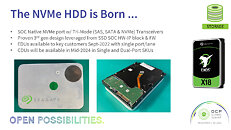TheLostSwede
News Editor
- Joined
- Nov 11, 2004
- Messages
- 18,887 (2.50/day)
- Location
- Sweden
| System Name | Overlord Mk MLI |
|---|---|
| Processor | AMD Ryzen 7 7800X3D |
| Motherboard | Gigabyte X670E Aorus Master |
| Cooling | Noctua NH-D15 SE with offsets |
| Memory | 32GB Team T-Create Expert DDR5 6000 MHz @ CL30-34-34-68 |
| Video Card(s) | Gainward GeForce RTX 4080 Phantom GS |
| Storage | 1TB Solidigm P44 Pro, 2 TB Corsair MP600 Pro, 2TB Kingston KC3000 |
| Display(s) | Acer XV272K LVbmiipruzx 4K@160Hz |
| Case | Fractal Design Torrent Compact |
| Audio Device(s) | Corsair Virtuoso SE |
| Power Supply | be quiet! Pure Power 12 M 850 W |
| Mouse | Logitech G502 Lightspeed |
| Keyboard | Corsair K70 Max |
| Software | Windows 10 Pro |
| Benchmark Scores | https://valid.x86.fr/yfsd9w |
Back in June, NVM Express, Inc announced the NVMe 2.0 specification, which included support for mechanical drives, also known as hard disk drives. Seagate has now demoed the first implementation of NVMe 2.0 on a HDD and is targeting market availability sometime in 2024. You might wonder why anyone would want an NVMe equipped hard drive and the short answer is that it's intended for the server space.
One of the key reasons that Seagate is even considering this, is because of its multi-actuator drives, which the company is expecting to surpass the interface speed of 12 Gbps SAS in the future. In addition to this, it makes sense having a single storage interface on servers, which allows for a mixed storage drive environment, where some drive bays can be fitted with SSDs and others with NVMe based hard drives. Seagate is planning to sample key customers with early drives in September 2022 and final drives will be backwards compatible with SATA and SAS.

View at TechPowerUp Main Site
One of the key reasons that Seagate is even considering this, is because of its multi-actuator drives, which the company is expecting to surpass the interface speed of 12 Gbps SAS in the future. In addition to this, it makes sense having a single storage interface on servers, which allows for a mixed storage drive environment, where some drive bays can be fitted with SSDs and others with NVMe based hard drives. Seagate is planning to sample key customers with early drives in September 2022 and final drives will be backwards compatible with SATA and SAS.

View at TechPowerUp Main Site








